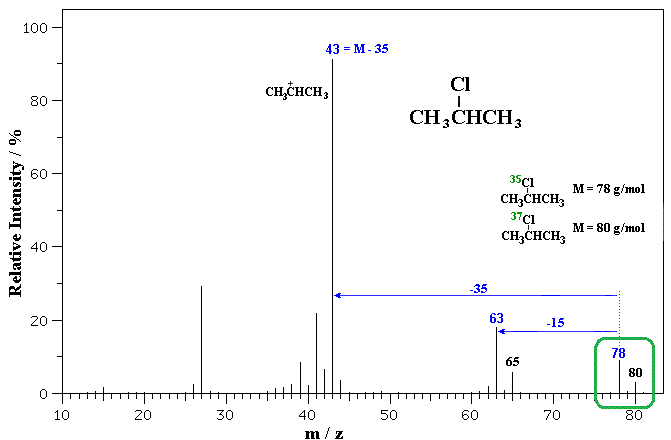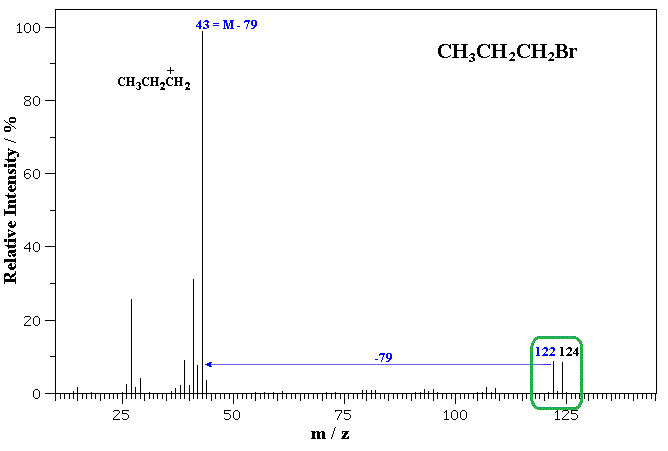 |
Chapter 13: Spectroscopy |
 |
Isotope patterns for -Cl and -Br
- Isotopes are different types of the atoms that have the same atomic number (i.e. same number of protons in the nulceus) but different mass numbers (because there are a different number of neutrons in the nucleas). Hence they are the same element but the isotopes have dfferent masses.
- Mass spectrometers are capable of separating and detecting individual ions
even those that differ only by a single atomic mass unit (note in reality mass spectrometers are far more sensitive than that !)
- As a result, molecules containing different isotopes can be distinguished.
- This is most apparent (at this level) when atoms such as bromine or chlorine are present in a molecule because those elements naturally exist with a significant % of the heavier isotope.
- For example, while C has 2 common isotopes, 12C and 13C, 13C represents only about 1% of natural carbon. In contrast, Cl has 2 common isotopes, 35Cl
and 37Cl, with about 25% being 37Cl.
- Typically, one looks at the molecular ion peak, "M" (since this is being identified and used to determine the MW).
- When working with MW from the molecular ion in MS, the best approach is to always use the lighter ion (i.e. M) and the mass of the lighter isotope (i.e. for Cl use 35 not 35.5, or, for Br use 79 and not 80).
- Note that it is not a good idea to look for Cl at m/z = 35 and 37 or Br at m/z = 79 and 81 as these peaks are typically very small.
- 35Cl
: 37Cl exists naturally in an almost 3:1 ratio, so we observe peaks at "M"
(molecules with an atom of 35Cl) and "M+2" (molecules an atom of 37Cl) are obtained with relative intensity 3:1

- 79Br : 81Br exists naturally in an almost 1:1 ratio, so we observe peaks at "M"
(molecules with an atom of 79Br) and "M+2" (molecules an atom of 81Br) are obtained with relative intensity 1:1

- Note that since the relative natural abundances of the isotopes are different, you can tell the difference between the presence of Cl and Br. The patterns are different, they look different.
- "M+1" peaks are usually seen due to the presence of 13C
in the sample but because 13C is only about 1% of natural carbon, the peaks tend to be small (unless there is a large number of C atoms present). Note that you can see the small peaks due to the presence of 13C in the figures shown for Cl and Br, they look like little shadows on the right of the other peaks.
The following two examples
of mono-haloalkanes mass spectra show the characteristic isotope patterns of monohalogenated molecules. The patterns are highlighted in the green boxes:
Example 1 :
This MS is of 2-chloropropane, C3H7Cl.

Note the characteristic Cl isotope
pattern at 78 (M) and 80 (M+2) in a 3:1 ratio. Careful inspection also shows very small peaks at 79 and 81 that are due to the presence of 13C isotopes.
Loss of 35Cl from M = 78 or 37Cl from 80 gives the base peak
a m/z = 43 (M - 35 = M+2 - 37 = 43) corresponding to the secondary propyl cation. Since the Cl has been lost, the M = 43 peak doesn't show a Cl isotope pattern.
Note that the peaks
at m/z = 63 and 65 represent fragment ions (M - 15 = loss of CH3) that still contain Cl and therefore also show the 3:1 isotope
pattern.
The very small peak at 79 represents M+1, the small number of molecules that contain 35Cl and an atom of 13C rather than 12C.
The even smaller peak at 81 presents M+2+1 = M+3, a very small number of molecules that contain 37Cl and an atom of 13C rather than 12C.
The peak at M = 44 is related to the M = 43 peak in that it represents the secondary propyl cation but those with an atom of
13C rather than 12C.
Example 2 :
This MS is of 1-bromopropane, C3H7Br.

Note the isotope
pattern at 122 and 124 represents the M and M+2 in a 1:1 ratio. Careful inspection also shows very small peaks at 123 and 125 that are due to the presence of 13C isotopes.
Loss of 79Br from 122 or 81Br from 124 gives the base peak a m/z
= 43, corresponding to the propyl cation.
Note that other peaks, such as those
at m/z = 107 and 109 (yes, they are small) still contain Br and therefore still show the 1:1 isotope
pattern.
Note: the isotope patterns for polyhalogenated molecules (such as having both -Cl and -Br or with multiple -Cl or -Br) give different (but still characteristic isotope patterns).



